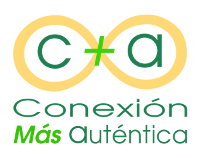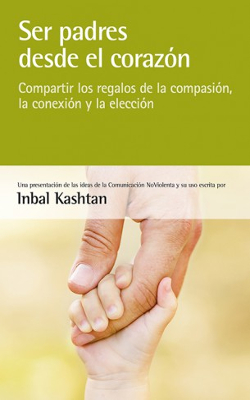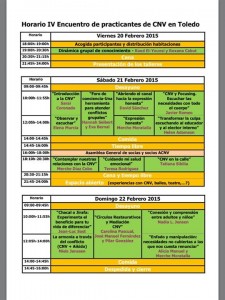Label: Interpersonal communication
My article on “Children and death”
31 October 2015.
Tags: Interpersonal communication, Mourning, Education, My Classifieds, For boys and girls, For parents, Psychotherapy, Therapy, Other Texts
In these final days of October the theme of death more frequently in the lives of children arises. Since the celebration of the Day of the Dead in certain families to all events of a different color of the Halloween, the reality is that it is a time when children can ask questions about death, and it is convenient to have prepared certain attitudes and listening spaces and answers.
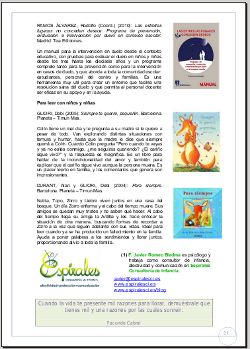 I wrote in 2011 an article that recovery here, “Children and death”, to remember some useful clues. In the article, published in the journal Our corner of 0-6 - ACCENT directed Childhood Education, They explore three key areas:
I wrote in 2011 an article that recovery here, “Children and death”, to remember some useful clues. In the article, published in the journal Our corner of 0-6 - ACCENT directed Childhood Education, They explore three key areas:
- The perception of death at different ages (between zero and six years, which it is the subject of the magazine).
- Some basic guidelines to accompany children to death.
- recommended reading, separate readings for families and professionals and stories to read with children.
Article framing and start with this paragraph:
For a long time it was thought that children did not suffer grieving process until older ages. However, research in the field of addiction have shown that pass through grieving process from the earliest ages, although it does not manifest like adults until later. Therefore it is necessary to speak of death (and not hide it for fear of damaging them) when it happens (or when it will happen, in the case of terminally ill), to understand 1) that the person is definitely going and 2) that the person does not leave voluntarily, and also so they can say goodbye, because if these concepts are not clear and not a farewell occurs, a pathological mourning may appear. And so it is important that we listen and pay attention to what happens inside when the death occurs in their lives.
[cite as: ROMEO BIEDMA, Francisco Javier (2011): "Children and death" Our corner of 0-6 - ACCENT, 60, 17-21.]
I hope that these reflections will serve to accompany this topic to children in your environment. Death is an inevitable part of life, and how better integrate, They will live more fully, our children and us.
I wish you a commemoration consciousness,
Focusing and Nonviolent Communication to repair the sexual exploitation
23 September 2015.
Tags: CNV, Interpersonal communication, Focusing, Focusing en Madrid, Psychotherapy, Therapy, Experiences
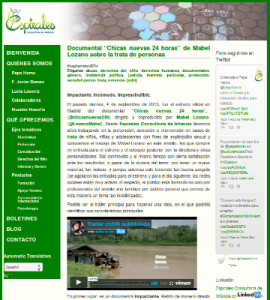 4 September 2015 past I had the honor of attending the premiere of the documentary “new girls 24 hours”, (@girlsnew24h) directed and co-produced by Mabel Lozano (@LozanoMabel). From Spiral Consulting Children, of which I have been a founding member since 2009, we have been working on prevention for years, detection and intervention in cases of treats children's, girls and adolescents for the purpose of sexual exploitation. so i wrote this blog in which I explain why I consider it to be a documentary shocking, uncomfortable and essential.
4 September 2015 past I had the honor of attending the premiere of the documentary “new girls 24 hours”, (@girlsnew24h) directed and co-produced by Mabel Lozano (@LozanoMabel). From Spiral Consulting Children, of which I have been a founding member since 2009, we have been working on prevention for years, detection and intervention in cases of treats children's, girls and adolescents for the purpose of sexual exploitation. so i wrote this blog in which I explain why I consider it to be a documentary shocking, uncomfortable and essential.
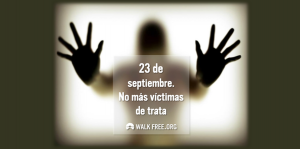
WalkFree.org, entity that fights against all types of modern slavery, has released this image to raise awareness today 23 September against sexual exploitation.
And I was left with the feeling of having more to say, somehow. Today, 23 of September, is he “International Day Against Sexual Exploitation and Trafficking in Women, Girls and boys” (The, rather technically, “against sexual exploitation and human trafficking”). So today may be a good day to make a second comment..
The weeks after seeing the documentary I was left with the special feeling. I became aware of all the possibilities offered by the Focusing and the Nonviolent Communication to help all people who have been trafficked for sexual exploitation, be women or men, girls or boys, the teenagers. Evidently, reparation for sexual exploitation is very complex and requires extensive social resources, and within psychosocial resources and therapy, you need a large availability of tools. What I offer here is a specific reflection of the contributions of these two processes that I know and that serve me to accompany people who have suffered some type of violence, especially sexual violence.
Focusing, which is a process of gentle listening to bodily felt sensations, It is a very powerful tool so that the person who has suffered sexual exploitation can recompose the relationship with their body. That body that has suffered so much damage and humiliation may have ways of expressing its pain that are harmful, both in the impulsive responses and in their blockages as well as in the relationships that it establishes. Focusing, with his “go step by step, to the rhythm that the body wants to show”, allows emotions to find a healthier way of expressing themselves and to gradually heal. At the same time, the person can recover their experience of the body “from inside”, little by little overcoming the barriers and dissociations that his body built in order to survive. You can read more about how I understand Focusing, and seeing some of the entries about Focusing that I have published in this blog.
On the other hand, the Nonviolent Communication It seems to me an enormously powerful tool for the person to recover the word. Person (woman or man, girl or boy), who has been denied the right to assert their opinion, to decide on your life, about his body and about his affectivity, can find support in two processes. On the one hand, Nonviolent Communication can accompany you in the way you narrate your story to yourself, to reformulate your life. This way you can prepare the necessary duels, and making decisions in a conscious and empowered way. On the other hand, Nonviolent Communication is also very useful in the field of relationships, and can help the person to communicate more authentically and assertively, and at the same time more respectful with herself and with other people. In this way you can empower yourself to reweave, with awareness, his network of affections. You can expand this information by reading about my understanding of Nonviolent Communication and some entries about CNV from this blog.
My memory goes to all the people who suffer sexual exploitation, and to those who work for their liberation and healing.
And my offer also goes to accompany in the repair of these processes, from the psychological accompaniment and the psychotherapy (en Madrid, for now).
With hope and awareness,
Xavier
“Connect with Respect” (“Respect for Me, Respect for You”), Bridget Belgrave material for Nonviolent Communication work with adolescents and young
18 September 2015.
Tags: CNV, Interpersonal communication, Education, Training, In English, Texts CNV, Videos
Last weekend 12 and 13 September 2015 I have had the privilege and pleasure of working again Bridget Belgrave. As I mentioned in this post, I met Bridget Belgrave already Gina Lawrie, Certified trainers for the Center for Nonviolent Communication (Center for NonViolent Communication, CNVC), in 2009 and from that moment we began to work together to translate NVC Dance Floors the Castilian. Completed translations finally saw the light in 2014, with some illustrative videos that can be viewed I made this entry for release. Association for Nonviolent Communication It has organized a series of training courses in Madrid, Bilbao and Barcelona during September 2015, and for me it has been a pleasure to work again with Bridget Belgrave support team with the translation from English into Castilian and vice versa.
In preparing the workshop I have spent time reviewing all the materials I have the NVC Dance Floors and of Bridget en particular. And valuing all materials, each with its wealth, there is one that is still my favorite. In fact, Bridget invited me to share my vision at some point of the workshop, and I happened also to extend my recommendation in this blog.
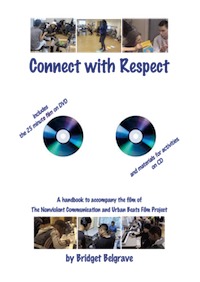 The material in question is only in English and not have subtitles or translations available, but I hope that does not discourage approach him. “Connect with Respect” (“Connect on respect”, literally translated into Castilian) is a multimedia material documenting a project that made Bridget Belgrave 2004 with 21 adolescents and young adults with an average age of seventeen. The project was proposed as an intervention to train boys and girls in situations of social difficulty Nonviolent Communication, within the framework of a workshop building urban rhythms, for ten weeks.
The material in question is only in English and not have subtitles or translations available, but I hope that does not discourage approach him. “Connect with Respect” (“Connect on respect”, literally translated into Castilian) is a multimedia material documenting a project that made Bridget Belgrave 2004 with 21 adolescents and young adults with an average age of seventeen. The project was proposed as an intervention to train boys and girls in situations of social difficulty Nonviolent Communication, within the framework of a workshop building urban rhythms, for ten weeks.
Why recommend? Here is a summary of my reasons:
- The DVD with the film, of 25 minute. Collect the key moments of the project, recorded therefore the three trainers as by young people themselves, and edited in collaboration with them. In fact, as told in a passage, the fact of viewing previous sessions helped them all become more aware of their own learning and getting behaviors that would be well suited to the needs of everyone. It is a graph document lets put faces (and sounds) to different situations, and lets figure out how to apply it in other contexts.
- The video is supplemented with the second part of the book, “Guide to the Film” (“Guide for the film”), on which sequence by sequence discussed everything that happens: each situation, how teaches Nonviolent Communication, Practice times, the real conflicts that arise… This will better understand the intent of each activity and the difficulties encountered and how they were addressed.
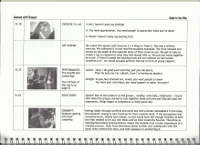
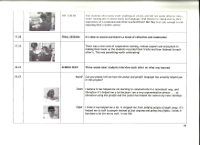
- And the third part of the book contains the complete program, ten weeks with all their detailed exercises and all materials also typeset (English), as well as incorporating a CD-ROM with the file of each material in PDF ready to print. Obviously the video does not collect all the exercises, so it is very useful to see the progression activity to activity, with the ability to replicate.
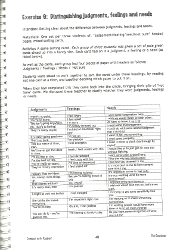
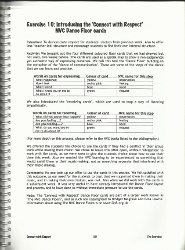
- The availability of a translation of what the Dance floor itself to Castilian, with title “Respect for Me, Respect for You”, within the complete package Dance Floors.
- And the caveat Bridget Belgrave not attempt a project of this type without having one hand a strong background and experience in Nonviolent Communication, and secondly an educational team with some basis of CNV and experienced in working with adolescents. I made some of these exercises with adolescents and youth at risk in Madrid and went well, so I'm available.
In summary, a material worth seeing, read, reread and implement. And you can buy in its online store, Life Resources.
And if you want more clarification, You can call me on my phone contact and discuss what you want.
I hope we can soon have more projects of this style here!
Xavier
Dance Floors CNV with Bridget Belgrave in Madrid 12 and 13 September 2015
13 September 2015.
Tags: Agenda filed, CNV, Interpersonal communication, Training
I have the honor and pleasure to support translating during the next workshop of the NVC Dance Floors which it is intended to impart Bridget Belgrave en Madrid, with organization Association for Nonviolent Communication.
I met Bridget Belgrave already Gina Lawrie, Certified trainers for the Center for Nonviolent Communication (Center for NonViolent Communication, CNVC), in 2009 and thereafter we begin to work together to translate NVC Dance Floors the Castilian. Translations finally saw the light 2014, with some illustrative videos that can be viewed I made this entry for release. now Association for Nonviolent Communication It has organized a series of training courses in Madrid, Bilbao and Barcelona during September 2015, and I have the pleasure to work again with Bridget Belgrave team supporting the translation from English into Castilian and vice versa in the formation of Madrid, which will focus on the topic “Talking without express or hear blame or criticism (Dance Dance Autoempatía and the 13 Steps for dialogue)”.
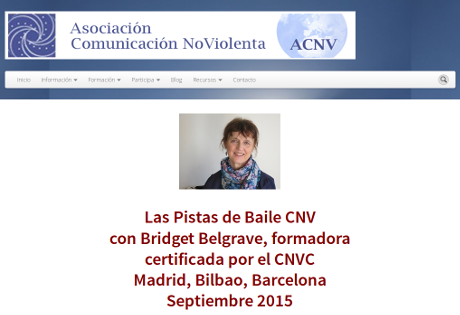 Dates: sábado 12 September 2015 of 10:00 a 14:00 and of 16:00 a 20:00 and Sunday 13 September 2015 of 10:00 a 14:00.
Dates: sábado 12 September 2015 of 10:00 a 14:00 and of 16:00 a 20:00 and Sunday 13 September 2015 of 10:00 a 14:00.
Place: Neuronilla room
C/ Doctor Cortezo 17, 2º
Madrid
[Original entry 2 September 2015, actualizada a 13 September 2015, date of completion of training.]
Book “Parenting from the heart” de Inbal Kashtan
6 May 2015.
Tags: CNV, Interpersonal communication, Education, For parents, Texts CNV
“According to my experience, the practice of Nonviolent Communication with young children is more a matter of what happens inside me-that way I talk to myself about what is happening with me and my son to negotiate. However, I also want to express in words my understanding of what is happening for both, at least part of the time, even if I think my child does not understand the language, because it helps me connect with the feelings and needs of both. That, at the same time, helps me calm down and find strategies that do work for both. I also want to speak aloud because I think this is the way to acquire language and emotional literacy.” (Inbal Kashtan, Parenting from the heart, page 38)
When people involved in my interpersonal communication workshops have sons or daughters who are in childhood or adolescence, or work with those ages, typically they arise “Yes, This way of communicating is very well among adults, but to see how I tell my son / niece / student / daughter…”. If time, practice communicating with children in training, but often I can only indicate possible suggestions and explorations. We now have a new resource, that lets you family communication to another level. This is not only to resolve conflicts (that also), but to create a more authentic connection type, deeper and more powerful, that prepares children for more resiliently life.
With this sensitivity Inbal Kashtan wrote his book Parenting from the heart. Share the gift of compassion, connection and choice, published last year in Castilian by Editorial Acanto. Inbal Kashtan, forming Nonviolent Communication and mother of a child, he led for years the work of Nonviolent Communication within the family, especially from parents to their children. Inbal died in September 2014, but his legacy continues baynvc (an organization that disseminates Nonviolent Communication from San Francisco Bay, California, of which he co-founded) and his writings (in addition to this book, You can read some of his articles about family communication in English baynvc). This blog also wants to be an acknowledgment and a tribute to his life and work.
I recommend this book both for those who come for the first time to Nonviolent Communication and for those who want to deepen their practice with children. Hope you enjoy the.
Xavier
Restorative Practices at school, a new way to resolve conflicts
5 May 2015.
Tags: CNV, Interpersonal communication, Education, In English, For parents, Texts CNV, Other Texts, Videos, Webs
Most disputes can be resolved in a satisfactory and beneficial way for all parties, provided that the necessary resources and time are dedicated. That's my personal and professional experience years learning, practicing and transmitting Nonviolent Communication. It's as basic (not easy) as the necessary conditions for that resolution occurs. For me there are several must-haves, which can be summarized as follows:
- An appropriate methodology, to allow all parties involved feel safe and respected in their rights.
- Professionals with experiential training in mediation and deep listening skills and “translation” messages to make them easier to listen to each person.
- A supportive community restorative processes, devoting time, spaces, human Resources, training…
- People willing to resolve conflicts in a way that ultimately all parties feel heard and that all parties leave satisfied with the solution.
So for me it is a joy to share the resources developed by a large community of people in the neighborhood are Gotleu in Palma de Mallorca (Mallorca), They are collecting and how they have worked each of those elements.
In this video you can see how they have been involved, with the revitalization of Institute for Coexistence and School Success (the Institute for Coexistence and School Success in Castilian) Government of the Balearic Islands, from the faculty of schools of Primary Education, Elementary and Secondary, students of all ages, the families, and Social Services, police, University and other significant social groups. A mosaic of voices, We make us an idea of the experiences of the creation of that network security in a socially vulnerable environment, and we see some results.
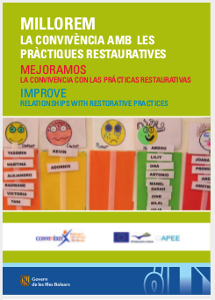 For a more systematic view, is the publication containing the fundamentals. Published in Catalan, Castilian and English as part of a European project this subject, the Guide to improve coexistence with Restorative Practices / Guide Mejoramos coexistence with the practices restorative develops the theoretical aspects of Restorative Practices, more accurate data and provides concrete examples and suggestions for further reading for more information.
For a more systematic view, is the publication containing the fundamentals. Published in Catalan, Castilian and English as part of a European project this subject, the Guide to improve coexistence with Restorative Practices / Guide Mejoramos coexistence with the practices restorative develops the theoretical aspects of Restorative Practices, more accurate data and provides concrete examples and suggestions for further reading for more information.
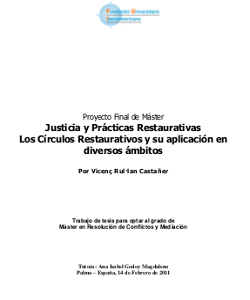 And to deepen the Restorative Circles, a practice of conflict resolution originated in the social dimension Nonviolent Communication, you can read the interesting monograph Justice and Restorative Practices. Restorative Circles and their application in various fields, written by Vicenç Rul·lan, a trainer who I have the pleasure of meeting, on the video and in the Guide, and he is a member of the Association of Restorative Justice Practices and Islands (to page Castilian and in Catalan, with several resources more). A good introduction, to further deepen this particular model. And you can also watch videos (English) on the official website of the creator of the Restorative Circles, Dominic Barter, RestorativeCircles.org.
And to deepen the Restorative Circles, a practice of conflict resolution originated in the social dimension Nonviolent Communication, you can read the interesting monograph Justice and Restorative Practices. Restorative Circles and their application in various fields, written by Vicenç Rul·lan, a trainer who I have the pleasure of meeting, on the video and in the Guide, and he is a member of the Association of Restorative Justice Practices and Islands (to page Castilian and in Catalan, with several resources more). A good introduction, to further deepen this particular model. And you can also watch videos (English) on the official website of the creator of the Restorative Circles, Dominic Barter, RestorativeCircles.org.
Who have done some training of interpersonal communication with me you have seen that ground mention this issue of Restorative Practices. I hope these resources illustrate a little better what you have heard me and I hope to awaken your creativity and your imagination to continue discovering more effective and deeper ways to resolve conflicts in the educational environment, and in any other area.
Xavier
Twitter True Connection More
20 March 2015.
Tags: Agenda filed, CNV, Interpersonal communication, Focusing, My Classifieds, Psychotherapy, Therapy, Webs
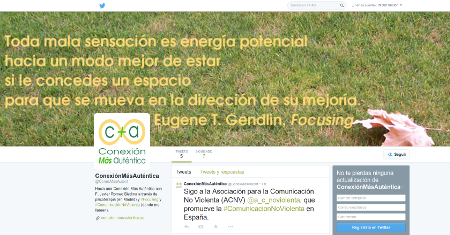 Taking advantage of spring begins today, More Authentic Connection has already Twitter, ConexMasAutent, where they appear different entries published, as well as recommendations and other matters of interest Focusing, interpersonal communication based on Nonviolent Communication, personal development in general and psychotherapy.
Taking advantage of spring begins today, More Authentic Connection has already Twitter, ConexMasAutent, where they appear different entries published, as well as recommendations and other matters of interest Focusing, interpersonal communication based on Nonviolent Communication, personal development in general and psychotherapy.
I hope that is helpful.
Xavier
I understand how psychotherapy: Key ideas and a video to illustrate
3 March 2015.
Tags: Interpersonal communication, For Teens, For boys and girls, For parents, Psychotherapy, Therapy, Videos
Explain to anyone what the psychotherapy, and especially what I understand as psychotherapy, It is always a challenge. And when this is added we want to explain it to children, or adolescents, It finds it harder. And yet, psychotherapy is perfectly natural: to recover the lost balance (and thus regain control of their lives).
As human beings we are basically ready to grow healthily. It would be natural that all people might be moving through the various stages of childhood, adolescence and adulthood step. It would be natural, well, on the one hand to incorporate the nutrient elements psychologically (body, emotional, cognitive, procedural, attitudinal…) and on the other hand trying to overcome the painful and even harmful elements with new learning (of the kind “This attitude of mine and does not serve me” The “I do not ever want to deal with a person who does not respect me”). However, Sometimes things go wrong (a little or a lot), and you need to do something to move forward with health. Psychotherapy is a good way to integrate and heal the experiences, regaining enthusiasm for our life.
The video “Garra rufa (Doctor Fish)”, It was developed by a group of students of animation Sheridan College under the name of Frozen Mammoth Productions, among others Timothy Chan and Eunice Hwang, and we can serve as the starting point to begin reflection.
This video seems a good example to explain several key points that I like to make clear to children and adolescents, and also adults who pose make a psychotherapy:
1) The work of those who act as therapists is recover the healthy and alive who's inside we see. We all have something valuable by the mere fact of its existence, although sometimes very harmful situations have occurred, the external internal.
2) To recover what we have healthy and alive variety of means, Suitable whom we have before (and at his age, their likes, his style, what has lived…). always we hear, often we ask, and sometimes we propose activities (how to draw, or perform specific activities, or trying different techniques). Our goal is to give back to the person that he is healthy and alive, but cleaner and stronger so you can move your life.
3) We know that the process takes time. If we take weeks, months, years, living with painful, we will also need time to heal dedication. It is true that there may be discoveries that we radically change our experience at a time, as it appears in the video, but that only happens when we have been investigating our inner enough. And it takes time for that experience is put in place globally in our lives.
4) And we know that The process involves an effort. It's like cleaning a wound that has become infected, It may involve momentary pain, but the improvement is evident in the long run. The effort affects people who are around who comes for consultation. For children, and adolescents, the effort affects the family, and from my vision of psychotherapy I intervene only if there is a clear and strong commitment from family (especially primary caregivers).
5) As in the video, as therapists know well the experience because We have lived our own psychotherapy with our own challenges. Of course we have specific training, broad and deep, but we do not consider exceptional people. We are simply people who have watched our pain and we have learned to look at the pain of others constructively and from new perspectives.
I hope the video will serve you to have some clearer ideas about psychotherapy, especially when you please explain the your children, and adolescents.
Xavier
Focusing Workshop on CNV and the Fourth Meeting of Nonviolent Communication practitioners 20-22 February 2015 Toledo
22 February 2015.
Tags: Agenda filed, CNV, Interpersonal communication, Training
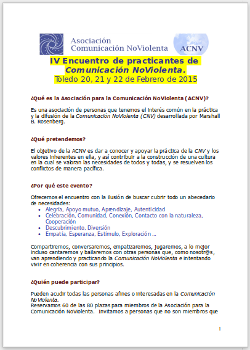 Taller “Nonviolent Communication and Focusing. Listen to the entire body needs” inside of the IV Meeting of Nonviolent Communication Practitioners organized by the Association for Nonviolent Communication.
Taller “Nonviolent Communication and Focusing. Listen to the entire body needs” inside of the IV Meeting of Nonviolent Communication Practitioners organized by the Association for Nonviolent Communication.
Dates: Friday 20 to Sunday 22 February 2015.
Place: Hostel San Servando
Cuesta de San Servando s / n
Toledo
To read the full information, request clarification and register, go to specific web page of the event.
To read a little about the theoretical basis of the workshop, You can consult my article “Combining Focusing and Nonviolent Communication. Reflecting deeper implications for”, which it was published in the number of 2014 of The Folio. A Journal for Focusing and Experiential Therapy, the official academic journal The Focusing Institute (Focusing Institute of New York).
[Original entry 30 January 2015, actualizada a 22 February 2015, end date of the meeting.]
Celebration of the life of Marshall Rosenberg and mourning over his death
18 February 2015.
Tags: Agenda filed, CNV, Interpersonal communication, Texts CNV, Experiences
They are being very poignant day between those who know and practice Nonviolent Communication. Marshall B. Rosenberg, creator of Nonviolent Communication, He has died last 7 February 2015 at the age of 80 years (We celebrated his birthday a few months ago in this post), and those who knew him and those who have learned general model are doing something that taught us: celebrate the events that have covered our needs and allow us to pass the duel of events that have left our unmet needs.
I had the pleasure of formarme with him during the nine days of the International Intensive Training (International Intensive Training, IIT) Switzerland in July and August 2008. Of that training is the photo that I have with Marshall and his wife Valentina, with the added symbolism of the presence of two boys and a girl unrecognizable in the background, that connects with the Marshall gave me encouragement in my work with children, and adolescents (read more details in the original entry).
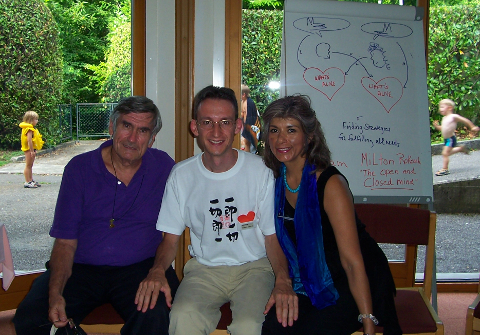
During these days, in which I read the various messages and commemorations that have occurred in the community of Nonviolent Communication, I also took the opportunity to reread the notes I lived those days with him (and in the company of other trainers and other participants). And later it will touch reread all his works, as a way to refresh and honor their work.
Marshall Rosenberg worked to create a more humane world, discovering aspects of life and growth even in the most incomprehensible acts. Your basic sentence is “Violence is a tragic expression of unmet needs”, and the method, Nonviolent Communication, a path to listen and reformulate expressions to find solutions in which all parties are winners.
For me it is especially enriching Marshall's emphasis on social change, he did not want to serve Nonviolent Communication for people he would tarry with her quiet life. The work begins within each person, but you can not stay there, it must reach different structures (economic, social, policies, Education…) and that transform humanizándolas. As he told us in Switzerland: “Our action is similar to that of someone who sees a baby fall down a waterfall and saves, and watching another and saves, and watching another and saves… At some point it will be convenient that person arises who is throwing babies and climb the waterfall to avoid”.
Apart from his writings (more than a dozen books, among them Nonviolent Communication. A language life) and videos and recordings of their workshops and their songs, Marshall leaves constituted the Center for Nonviolent Communication (Center for NonViolent Communication), with a history of decades of work, and that it has been operating without recent years. It also leaves hundreds of certified trainers that their model is still transmitted with fidelity and tens of thousands of practitioners who try to put some light in our daily conflicts. It is something to celebrate.
At the same time, his passing leaves a void. Knowing that he has died at his home accompanied by his wife Valentina and their children is a minor consolation. We know that and we will see not representing new conflict situations, you will not hear any new songs, not write new books. And that alone is host to compassionate the pain and sorrow that appear.
Only by integrating the full experience we can move on fully, integrating the received Marshall and looking, moment by moment, how to update an enriching way for everyone.
In celebration and mourning,
Xavier
